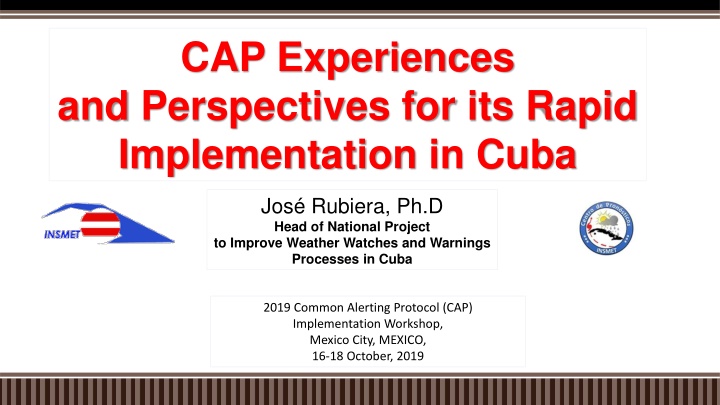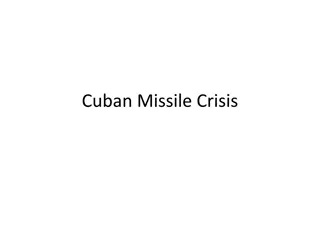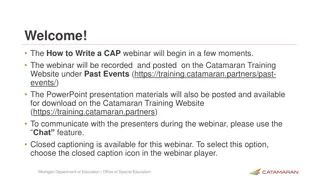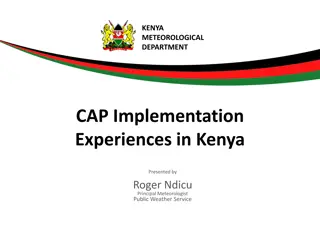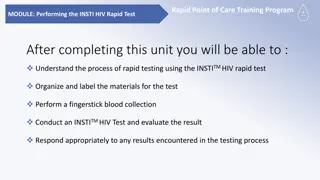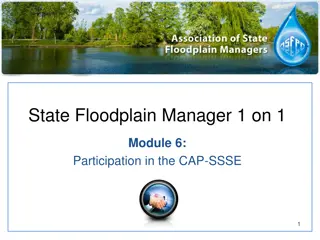CAP Implementation in Cuba: Experiences and Perspectives for Rapid Progress
José Rubiera, Ph.D., discusses the urgent need for implementing the Common Alerting Protocol (CAP) in Cuba to enhance weather watches and warnings. The challenges faced by the Cuban Meteorological Service are explored, along with plans for CAP implementation in 2020. The overview of Cuba's weather hazards and the structure of the Cuban National Meteorological Service are also highlighted, emphasizing the significance of CAP for disaster preparedness.
Download Presentation

Please find below an Image/Link to download the presentation.
The content on the website is provided AS IS for your information and personal use only. It may not be sold, licensed, or shared on other websites without obtaining consent from the author.If you encounter any issues during the download, it is possible that the publisher has removed the file from their server.
You are allowed to download the files provided on this website for personal or commercial use, subject to the condition that they are used lawfully. All files are the property of their respective owners.
The content on the website is provided AS IS for your information and personal use only. It may not be sold, licensed, or shared on other websites without obtaining consent from the author.
E N D
Presentation Transcript
CAP Experiences and Perspectives for its Rapid Implementation in Cuba Jos Rubiera, Ph.D Head of National Project to Improve Weather Watches and Warnings Processes in Cuba 2019 Common Alerting Protocol (CAP) Implementation Workshop, Mexico City, MEXICO, 16-18 October, 2019
TOPICS Overview on Cuba. Cuban National Meteorological Service: Instituto de Meteorolog a. Why CAP Implementation is a Need in Cuba?. Difficulties for the Use of CAP in Cuban Met Service at an earlier time Evolution of Telecom and Internet in Cuba 2018 - 2019. Inmediate Plan to Implement CAP in Cuba in 2020.
Overview on Cuba Source: Google Maps
Overview on Cuba Main Weather Hazard: HURRICANES Source: Google Maps
Overview on Cuba TORRENTIAL RAINS Lowland Floodings Flash Floodings in Cities SEVERE THUNDERSTORM Flash Floods Strong Local Winds Hail Tornado STRONG WINDS COASTAL FLOODINGS Source: Google Maps
Overview on Cuba Area: 110 922 km Coastline: 5 746 km Population: 11 million Capital: Havana 2.5 million inh. Havana Havana Province 16 provinces
Cuban National Meteorological Service: Instituto de Meteorolog a Havana 1 National Meteorological Center Havana Province 16 Provincial Meteorological Centers 16 provinces
Cuban National Meteorological Service: Instituto de Meteorolog a RED DE ESTACIONES METEOROLOGICAS (CLIMATOLOGICAS) WEATHER STATION NETWORK IN CUBA 328 325 376 374 340 318 329 373 330 327 323 375 316 312 320 338 326 339 322 317 315 332 331 348 336 314 343 335 344 313 347 349 333 342 309 346 352 310 337 345 321 341 353 350 355 354 358 370 LEYENDA 378 365 357 351 362 Estaciones 372 68 Meteorological Stations 1 Upper Air Sounding Station 361 371 369 Pinar del R o 310 Cabo San Antonio 312 Santa Luc a 313 Isabel Rubio 314 San Juan y Mart nez 315 Pinar del R o 316 La Palma 317 Paso Real de San Diego 318 Bah a Honda Ciudad de la Habana y La Habana 325 Casablanca 373 Santiago de las Vegas 320 Guira de Melena 322 Bataban 323 Guines 340 Bainoa 374 Tapaste 375 Melena del Sur 376 Bauta 1 Lidar 2 Satellite Earth Station Matanzas 327 Uni n de Reyes 328 Varadero 329 Indio Hatuey 330 Jovellanos 331 Jaguey Grande 332 Col n 333 Playa Gir n Cienfuegos 335 Aguada de Pasajeros 344 Cantarrana Villa Clara 326 Santo Domingo 338 Sagua La Grande 343 El Yab 348 Caibari n Sancti Sp ritus 337 Trinidad 341 El J baro 342 T pes de Collantes 349 Sancti Sp ritus Granma 359 Manzanillo 360 Cabo Cruz 361 Jucarito 377 Veguitas Santiago de Cuba 363 Contramaestre 364 Universidad Guant namo 319 Valle de Caujer 334 Yateras 356 Jamal 368 Guant namo 369 Punta Mais Isla de la Juventud 309 Amistad Cuba-Francia 321 La F Ciego de Avila 339 Cayo Coco 345 J caro 346 Venezuela 347 Camilo Cienfuegos Camaguey 350 Florida 351 Santa Cruz del Sur 352 Esmeralda 353 Nuevitas 354 Palo Seco 355 Camaguey Las Tunas 357 Las Tunas 358 Puerto padre Holgu n 362 La J quima 365 Punta Lucrecia 370 Guaro 371 Pinares de Mayar 372 Pedag gico 378 Velazco 334 377 368 359 356 363 364 68 Estaciones de Superficie 24 Agrometeorologicas 12 Contaminacion 6 Radiacion Solar 7 Radares 2 Aerologicas 319 360
Cuban National Meteorological Service: Instituto de Meteorolog a NMTN digitally provides all relevant exchange of meteorological information in the Country, linking the National Met. Center with all Provincial Met. Centers
Cuban National Meteorological Service: Instituto de Meteorolog a 8 Weather Radars covers the entire Coutry and sea areas sorrounding Cuba
Cuban National Meteorological Service: Instituto de Meteorolog a DATA INPUT ANALYSIS AND NUMERICAL GUIDANCE DIFUSSION OF WARNINGS RESPONSE ACTIONS NATIONAL FORECAST CENTER SATELLITES RADARS WEATHER STATIONS UA SOUNDINGS SHIPS BUOYS AIRCRAFTS NUMERICAL MODELS
Why CAP Implementation is a Need in Cuba? Leading Time for Watches and Warnings in Cuba
Why CAP Implementation is a Need in Cuba? While Tropical Cyclones has a pretty good Watch and Warning System that has worked very well in years (just few or almost no fatalities in Cuba, even in very strong huracanes) Leading Time for Watches and Warnings in Cuba
Why CAP Implementation is a Need in Cuba? Others, generally have not that success, because lead times are shorter and diffusion of information is not as effective as in hurricanes Leading Time for Watches and Warnings in Cuba
Why CAP Implementation is a Need in Cuba? The main problem: Local Severe Storm and its related features: Flash Floods Strong Winds Wind Waves at the coast Hail Tornado Leading Time for Watches and Warnings in Cuba
Why CAP Implementation is a Need in Cuba? The main problem: Local Severe Storm and its related features: Flash Floods Strong Winds Wind Waves at the coast Hail Tornado Leading Time for Watches and Warnings in Cuba Just 30 minutes or less of Lead Time for Warning a Small Area
Why CAP Implementation is a Need in Cuba? CAP is the only way to alert people in very fast developing dangerous weather. An example was the squall line that effected Havana (> 2 million inhabitants) on April 29, 2015. Satellite This severe local storm developed rapidly just in front of Havana. Only a 20-min lead time to warn . of course, the warning couldn t go through .. Nobody received it before the event. Radar Winds were up to 27 m/s in a few minutes Atmospheric Pressure dropped to 998 hPa
Why CAP Implementation is a Need in Cuba? The main hazard in this event was the heavy and intense rainfall that disrupted all normal affairs in the 2-million inhabitants city, but fortunately with just one fatality Heaviest precipitation fell in about 20 minutes. Greatest amounts were recorded in downtown Havana: 239 mm in Plaza de la Revoluci n; 197 mm in Cerro; 188 mm in Loma de la Cruz; 186 mm in La Palma; and 171 mm in Habana del Este
Why CAP Implementation is a Need in Cuba? City normal life completely disrupted in 15 minutes
Why CAP Implementation is a Need in Cuba? The most intense rainfall lasted less than half an hour The night fell over a flooded city that was without electric power Havana completely under water
Why CAP Implementation is a Need in Cuba? Severe Local Storm with Very Strong EF-4 Tornado hits Havana City January 27, 2019 AVERAGE TRANSLATION SPEED: 60.6 km/h TRACK: 21.8 km MAXIMUM WIDTH: 310 m ESTIMATED WINDS: 320 km/h DURATION: 20 minutos HABANA DEL ESTE REGLA GUANABACOA SAN MIGUEL DEL PADR N CERRO DIEZ DE OCTUBRE
Why CAP Implementation is a Need in Cuba?
Why CAP Implementation is a Need in Cuba? People s Life Completedly Changed in those 20 minutes Fortunatedly only 7 fatalities, but the Tornado swatch rea was almost completedly destroyed There was NO WARNINGS, other than general conditions favored severe thunderstorm reas to develop in Western Cuba
Why CAP Implementation is a Need in Cuba? With this information and CAP, something else could have been done to warn people on an impending threat Havana Weather Radar Imagery 20:00 to 20:45 January 27, 2019.
Difficulties for the Use of CAP in Cuban Met Service at an earlier time At InsMet: Internal tests were made in 2015 using InsMet web page, with no graphic. People that were trained al that momento, later moved to other positions outside InsMet. Smart Alert Finnish software was installed in 2017, but technical problems prevented it to be fully operational.
Difficulties for the Use of CAP in Cuban Met Service at an earlier time Country Infrastructure (2014 2018) also prevented the use of CAP: Internet not widely used in the Country; Only available for a small amount of people, roughly 3 million users, 25 % of 11.3 million inhabitants in 2014. Very Slow Internet connection, normally no wide band. Very high cost for one-hour surfing of the web, around 8 - 9 % of an average monthly salary after a 50 % price off being in effect since July 2015. Cell phone are available for many people, but still below 40 % of the population. No Internet Connection in cell phones.
Evolution of Telecom and Internet Cuba in late 2018 and 2019 Telecom scenario is rapidly changing in Cuba
Evolution of Telecom and Internet Cuba in late 2018 and 2019 Million Mobile Lines Wi-Fi Areas Permanent Accounts New Contracts of Conectivity to Enterprises Million with Data Access Surfing Places Home Internet Connections
Evolution of Telecom and Internet Cuba in late 2018 and 2019 Tests with 4G Home Internet Conections Internet in Mobile Phones (3G) Prices have been going down with time Test of Home Internet Conections
Evolution of Telecom and Internet Cuba in late 2018 and 2019 Internet Coverage by Persons At the End of 2019 4G Radio Base Stations 3G Radio Base Stations Internet Coverage by Territory
Evolution of Telecom and Internet Cuba in late 2018 and 2019
Evolution of Telecom and Internet Cuba in late 2018 and 2019 Conditions favor InsMet towards the Use of CAP in a New Fashion National Watch and Warning System
Inmediate Plan to Implement CAP in Cuba 2020 The National Forecast Center of InsMet, as well as the 16 Forecast Departments in Provinces has the mandate to issue Weather Watches and Warnings for their respective territories of responsability, National or Provincial, in a completedly transparent and coordinated way, as it is stated in the National Operational Plan. CAP comes as a very useful tool to acomplish that mandate. The implementation of CAP in Cuba has been framed into a National Project, already approved by the Scientific Council of InsMet, with the Goal to improve the Weather Watches and Warnings System in the Country along 2020. Some of the Tasks that have been identified into the Project Plan are the following:
Inmediate Plan to Implement CAP in Cuba 2020 To Train specialist at InsMet National Forecast Center on the National issuance of CAP Alerts To Establish the Official issuance of CAP Alerts in the InsMet WEB and RSS feeds. To Train specialist at the Provincial Meteorological Centers to issue CAP Alerts for their territory of responsability.
Inmediate Plan to Implement CAP in Cuba 2020 To Begin displaying also Provincial CAP Alerts through the WEB and RSS feeds in the Provincial sites as well as in the InsMet website. To Develop a National App to be installed into Intelligent Phones to automatically display Cuban CAP Warnings, both National and Provincial, as a Push Service through that free App, taking into account the basis of user location.
Inmediate Plan to Implement CAP in Cuba 2020 A First Step, a Steady Purpose; we are Confident in its Success
Thank you, Muchas Gracias Jos Rubiera, Ph.D Head of National Project: Improving Weather Watches and Warnings Processes in Cuba rubiera.jose@gmail.com
